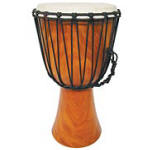| |
HISTORY

Rutting, whine, laments and shouts, whispers and
sing. The penetrating depth of its bass and the clarity of its claps
are the evidence of the wealth of its story. It’s the drum with the
endless rank, the “one thousand aspects drum”.
This grial formed the hand drum known by the African tribes as
D’Jembe, it was inherited b the Melinke and tribes from Sousou of
Guinea in Eastern Africa. You can find the cultural and historical
roots of these tribes in the great Mali Empire on the Eastern coast
of Africa. Its legacy has been preserved along the centuries and you
can see them in prayers, laments and narrations from “riots”
musicians travelling through the jungle. It’s accompanied by the
Cora ( an instrument of chords and box and pumpkin resonance. They
instrument and give a voice to the cultural prudences and the
historical facts of Sundiata descendants. He was a great warrior
from the Mali Empire. They enjoy the special states that were given
to them as the “words guardians”(as the Guinea writer Layer
Camara has said).
Methodology:
I PROVIDE PC
MUSIC SOFTWARE FOR WINDOWS 64 BITS FOR RHYTHM READING WITH REAL
D'JEMBÉ SOUNDS, WHICH MAKES LEARNING EASIER.
YOU CAN LEARN THE RHYTHMS BY LISTENING TO THEM AS THEY SOUND, YOU
CAN LEARN TO READ THEM BY MUSIC AND PLAY THEM AND YOU CAN PLAY THE
RHYTHMS AT THE SAME TIME AS THE SOFTWARE AND ALSO CHANGE THE SPEED
OF PLAYING.
D’Jembe study includes:
Different types of sounds
Technical study
Musical reading
African rhythms:Fankani, Kakilambe,Mandiani, Abondan,
Bolokonondo, Lolo, Tiriba, Yankadi, Moribayassa.
Assembling
Polyrhythms
|
|

